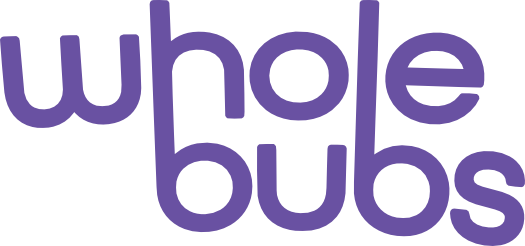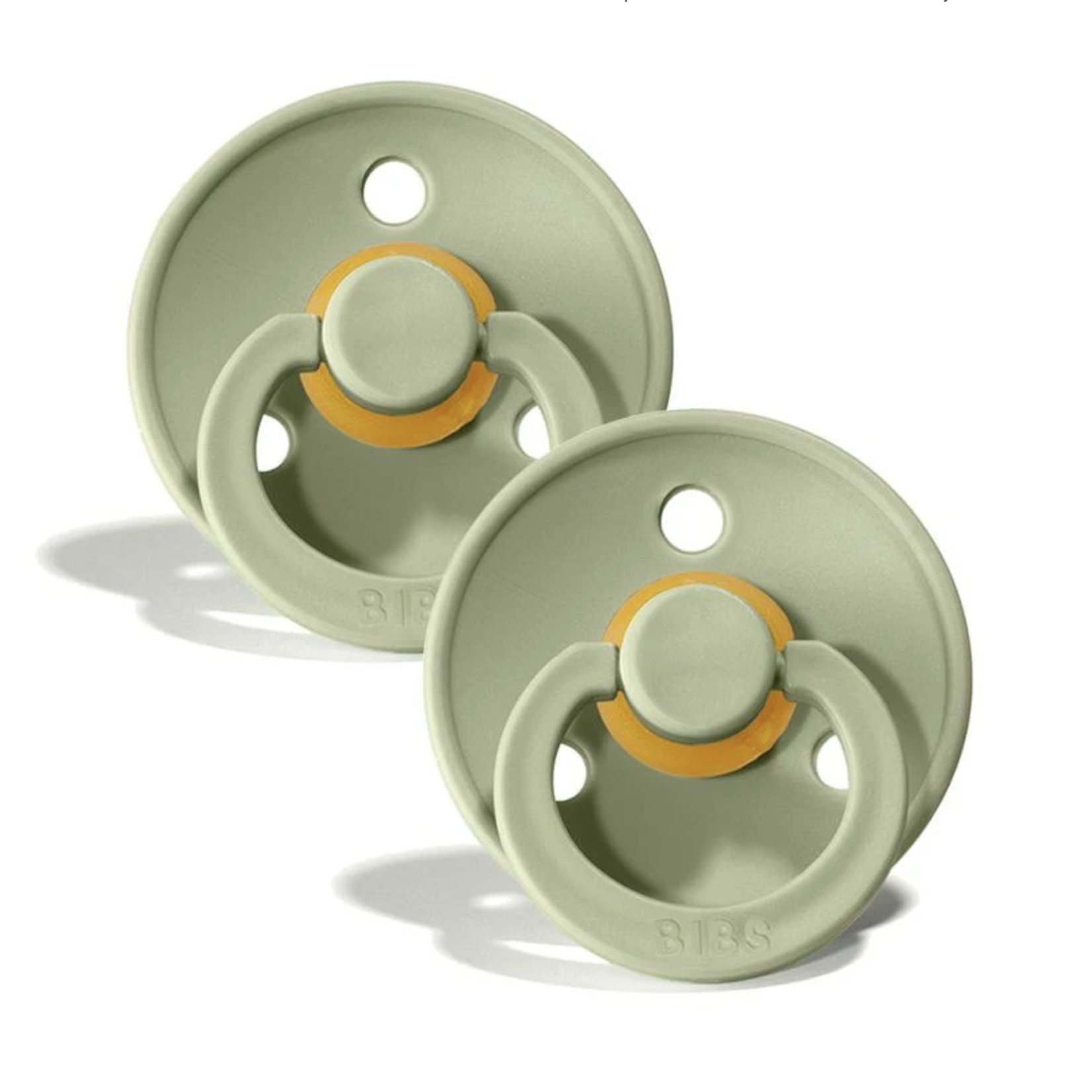Our Colour pacifier is the original BIBS pacifier and has been on the market for over 40 years. It has the signature round BIBS shield with three vent holes and round BIBS engraved handle ring.
The nipple is round and resembles the shape and size of the mother's breast to provide comfort to your baby.
- Available in natural rubber latex.
- Recommended by midwives to support natural breastfeeding.
- Also available in a night version with glow in the dark handle.
- The shield is made of 100% food-safe material. Completely free from BPA, PVC, and phthalates.
- Designed and manufactured in Denmark/EU.
Nipple information
The round nipple promotes a similar tongue placement and sucking technique when breastfeeding, since the round shape allows the sides of the tongue to elevate and cup around the nipple, just like it does during breastfeeding.
The nipple is equipped with a valve, letting out air when the baby closes down on the nipple. This ventilation system causes the air from inside the nipple to be pushed out through the valve thereby flattening the nipple to shape naturally after the baby's oral cavity.
The valve is also the reason why water can be presented inside the nipple after cleaning and sterilization. If this is the case, simply just squeeze the nipple flat to press out the excess water.
Shield information
The round lightweight shield faces away from the sensitive and delicate skin around the baby's mouth to ensure minimum contact with the baby's nose and mouth, which means less chance of moisture build-up from saliva that can cause rashes and sore spots.
The shield comes in one size no matter the nipple size.
Available in sizes 1, 2, and 3.
It is important to inform you that our different sizes are only a guide for you to follow. Our experience is that the following sizes are the general and therefore also our common recommendation.
- Size 1: 0+ months
- Size 2: 6+ months
- Size 3: 18+ months
Material
- The shield is made of 100% food-safe material. Completely free from BPA, PVC, and phthalates.
- The nipple is produced from natural rubber latex. Since natural rubber latex is a natural material, color variation may occur.
Quality
- Designed and manufactured in Denmark/EU.
- Complies with the European Standard EN 1400+A2.
Ethically produced
We develop our products with the greatest consideration for the planet and for the children who will inherit it.
How to sterilize the pacifiers
Part of good pacifier hygiene is frequent cleaning of the pacifiers. The younger the child, the more important it is to protect it from bacteria and to maintain good pacifier hygiene.
Before first use
Before first use (when you take the pacifier out of the packaging), sterilize the pacifier by putting it in plenty of boiling water for 5 minutes (like in a pot on the stove where the water will be boiling for the entire 5 min.) Remember to keep an eye on the water level when boiling so that the shield does not burn on the pot. This only applies before first use.
When cleaning the pacifier subsequently, follow these three simple steps:
- Put the pacifiers in a clean bowl. Pour them with plenty of boiling water.
- Let the pacifiers soak for approx. 5 min.
- Pick them up and let them dry on a clean towel.

TIP: When the child is over 3 months, you can also rinse the pacifier by placing them in a sieve and pouring them with boiling water. This method is faster and avoids water collecting inside the nipple.
After cleaning it is not unusual that water remains in the nipple. This is due to the fact that all our pacifier nipples are equipped with a valve, letting out air when the baby closes down on the nipple. This ventilation system causes the air from inside the nipple to be pushed out through the valve thereby flattening the nipple to shape naturally after the baby's oral cavity. The valve is also the reason why water can be present inside the nipple after cleaning and sterilization. If this is the case, simply just squeeze the nipple flat to press out the excess water. If water drops remain in the nipple, just let the pacifier air-dry.
Natural rubber latex can in rare cases smear off to the shield, so it is important to scald in plenty of water and not too many pacifiers at a time.
Do not cook!
Pacifiers are not meant to be boiled and are therefore destroyed by the high heat. Instead, follow the instructions above, and you are sure to kill the bacteria without compromising the durability of the pacifier.
Don’ts
- Do not leave natural rubber latex pacifiers in direct sunlight.
- Do not put the pacifiers in the dishwasher.
- Do not use UV or steam sterilizers for the pacifiers.
- Do not freeze the pacifiers.
How often should I clean the pacifiers?
Part of good pacifier hygiene is frequent cleaning of the pacifiers. The younger the child, the more important it is to protect it from bacteria and to maintain good pacifier hygiene. This is mainly because small children’s immune system has not yet managed to get acquainted with all the different bacteria, and therefore it will not have learned to “defend” against them yet.
Premature infants and babies up to 3 months need more thorough and frequent cleaning than babies over 3 months of age. Therefore, the pacifier must be cleaned more often when the child is under 3 months. We always recommend that pacifiers are scalded at least once a day.
Do not use UV sterilizers for latex pacifiers
Since natural rubber latex is a natural material it undergoes a natural aging process, which can be influenced by external forces such as UV light. Therefore, never use a UV sterilizer for our BIBS latex pacifiers as it will damage the material.
Do not use steam sterilizer devices for latex pacifiers
There are two reasons to why we do not recommend stream sterilizer devices:
- We have not tested our pacifiers in all these different devices and cannot guarantee that the latex will not break due to the high temperatures.
- Latex will break down if the temperature exceed 100°C. To use steam sterilizers people, need to check the manufacturer’s instructions for the sterilizer in relation to heat and watts, to make sure the temperature does not exceed 100°C.
Do not use sterilizing solution for latex pacifiers
We do not recommend using sterilizing solution for latex pacifiers, as the solution can damage the latex if the pacifier is left in for longer than recommended.
Do not use dishwasher cleaning
Do not clean the pacifiers in a dishwasher. The cleaning agents will damage the material (both latex and silicone) and it can become brittle. Furthermore, most dishwashers do not reach temperatures high enough to sufficiently sterilize the pacifiers.
What about microwave sterilization?
Be aware that latex will break down if the temperature exceed 100°C. Silicone endure higher temperatures that latex, however our general recommendations are that to use microwave sterilizations you must check the manufacturer’s instructions in relation to heat and watts, to make sure the temperature does not exceed 100°C. In most microwaves the pacifiers must be heated for a maximum of 60 seconds at max. 800W. Otherwise temperatures will exceed 100°C.
NB: Always check the manufacturer’s instructions! And always remember to put the pacifiers in water in a sterilization box made for the purpose. Never place the pacifiers in the microwave without!




